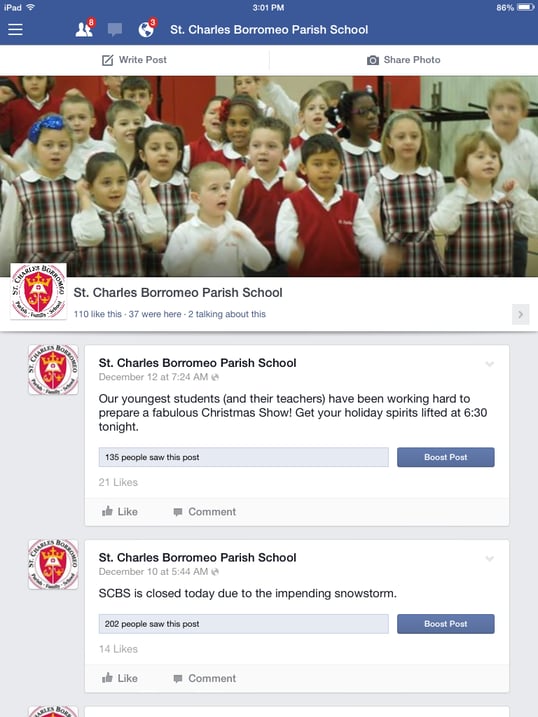Many Catholic schools seeking unique marketing alternatives are turning to social media networks like Facebook and Twitter to help get the message out. While using social media to promote schools can be tricky, it’s definitely an avenue worth pursuing as we approach enrollment time for fall 2014. Catholic Schools Week is scheduled for the end of this month, and it’s the perfect time to launch a social-media blitz promoting your school.
I’ve been managing the social media for my younger son’s Catholic school for about a year now. Before I opened Facebook and Twitter accounts for the school, I attended a diocesan seminar on using social media for school publicity and held a conference with the pastor, principal and technology teacher.
Networking and Network Issues
Regular networking with the school administration, the parish (which also has a Facebook page and will cross-promote ours), the PTA, and the marketing committee keeps the material fresh. The technology teacher is a vital part of the team; while she does not manage the page, her input as to content and focus is essential, as is the steady stream of carefully-checked photos she supplies.
Ironically, no one in the school is able to access the school’s social media pages using the school’s network connection due to the filtering system used. If I want to update the pages while I’m in the school building, I have to use my smartphone’s data plan. Usually I just wait until I get home to post updates.
Safety First
Before our social-media accounts were even opened, our principal sent a notice to every family informing them that we’d be using Facebook and Twitter. Families were asked to return a permission form that would allow student pictures on Facebook, Twitter and the school website. They could opt out of one or more of these sites. As the school’s technology teacher maintains the school website, she keeps the list of students who may not appear on social media and checks every photo before she forwards it to me for posting.
No student names are ever posted on Facebook or Twitter. We do, however, post links to articles on the school website when noteworthy events occur.
When setting up a Facebook page for a school, it’s advisable to use the page settings to ensure greater security. Be sure that tagging of photos is disabled and that only page administrators can post photos, videos, and status updates.
No Comment
A comment-box debacle involving a local online newspaper and the public school in town convinced our principal that the ability to post comments was a deal-breaker. Unfortunately, Facebook does not provide a way to disable comments on a fan page. I thought we were at an impasse until I was able to show her that the Pages app for mobile devices would alert me to any comment as it was posted, and I’d be able to delete it immediately. While the process is a bit cumbersome, it’s important to keep comments off the page.
Every so often I post a reminder on the page that we do not allow comments in the interest of student safety. When I remove a comment, I message the commenter and explain the reason for removal. So far, every single comment I’ve removed from the page has been a positive one, which speaks well for the school community, but our school administrators’ caution is definitely warranted.
Free Publicity Has a Price
Marketing can be expensive, so using free solutions such as Facebook and Twitter is tempting to schools and parishes with limited budgets. But these accounts must be updated and monitored frequently. When a volunteer becomes overburdened with other commitments, the school’s publicity efforts suffer. For this reason, it’s wise to set up a publicity team with two or three people who have the authority to post updates and photos. To do this, the original admin of the page must be “Facebook friends” with the other moderators—and all moderators must have the trust of the principal and pastor. My plan this year is to put such a team in place, as our school does not have one at the moment.
Show, Don’t Tell
We’ve found that photos get better responses on Facebook than simple status updates. Families love to see happy children doing fun and unique things at school. If we can’t always show the children’s faces, we can sometimes find a way to show their projects (with names obscured). Some of the events we’ve highlighted over the past year include the science fair, Dr. Seuss’ birthday, graduation, First Holy Communion, Living Stations of the Cross, and our annual field day.
Social media can allow a view into the school that goes beyond open houses and PTA meetings. Using Facebook and Twitter permits parents to show their friends what their children’s school is all about. Grandparents also enjoy checking the page to see if their grandkids appear in any of the photos. Overall, my experience in building and maintaining social-media accounts for the school has been rewarding.
Does your Catholic school effectively use social media as a publicity tool?
Copyright 2014 Barb Szyszkiewicz
About the Author

Barb Szyszkiewicz
Barb Szyszkiewicz, senior editor at CatholicMom.com, is a wife, mom of 3 young adults, and a Secular Franciscan. Barb enjoys writing, cooking, and reading, and is a music minister at her parish. Find her blog at FranciscanMom and her family’s favorite recipes with nutrition information at Cook and Count. Barb is the author of The Handy Little Guide to Prayer and The Handy Little Guide to the Liturgy of the Hours, available from Our Sunday Visitor.




.png?width=1806&height=731&name=CatholicMom_hcfm_logo1_pos_871c_2728c%20(002).png)
Comments